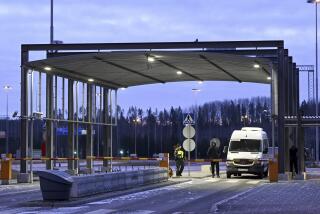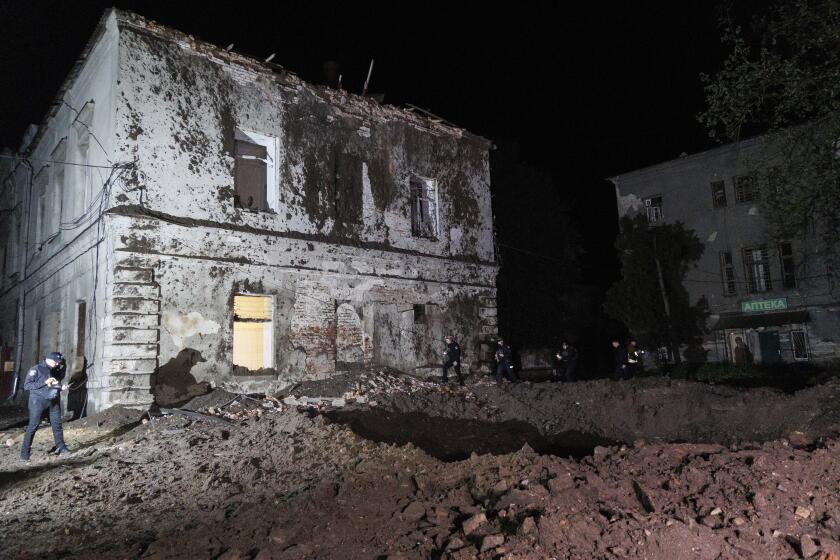Place Names Narrate Migrants’ Saga
The scrub oak tree that marks the human smuggling trail into California invites migrants to rest from the arduous mountain crossing. Weary men, women and children drink from water bottles and seek shade from the searing sun.
When the migrants sit back -- still facing a six-hour hike to the border -- the bandits pounce.
They steal the migrants’ meager belongings and strip off their clothing looking for money stitched into the seams. The underwear is then tossed into the branches.
That’s how the tree got its name: El Arbol de los Calzones, or the Underwear Tree.
Across the wild terrain of California’s frontier with Mexico, the evocative names of trees, canyons, mesas and other landmarks tell the tales of hope, fear and sometimes death.
Like the place names of the Old West and the California Gold Rush -- Cowboy Pass, Deadman Canyon, Miners Gulch -- the border names illustrate an era shaped by the saga of illegal immigration.
They are reminders of the journeys and adventures of desperate immigrants, heartless bandits, overwhelmed U.S. Border Patrol agents and ruthless migrant smugglers.
Toponyms, the geographic term for place names, have been showing up on Mexican maps as authorities near completion of a chart of human smuggling routes into California. The U.S. Border Patrol has similar operational maps, which help guide helicopters and ambulances to remote areas.
Some names aren’t charted but appear in training manuals or are sprinkled in the everyday vocabulary of the tightknit border rescue crews and law enforcement teams. The forces roam California’s 150-mile frontier with Mexico, a largely desolate wilderness where only migrants and their pursuers dare to venture.
“We have to give terrain features names. It’s not like we can call for backup at 10th and Broadway,” said Steve McPartland, a supervisory Border Patrol agent.
Mexican authorities, who decided to map the border last year, walked the same trails used by the immigrants and their guides. They took Global Positioning System readings, marking cow pastures and mesas where helicopters could land.
When Mexican rescue forces give directions in the rugged canyons and mountains east of Tecate, a key reference point is El Arbol de la Virgen -- the Tree of the Virgin.
The oak tree, located in a ravine several miles down a deeply rutted dirt road, is named for a small shrine in its hollowed-out trunk. Migrants say a prayer, light candles and hang rosary beads on statuettes of saints, then head north.
So many have failed in their efforts to cross the border, say Mexican authorities, that the surrounding area on maps is called El Valle de los Perdidos -- the Valley of the Lost Ones.
The immigrants “say a prayer so that it goes well on their journey,” said Felipe Flores, an agent with the Mexican migrant safety force, Grupo Beta. “They also pray that they don’t get picked up by Border Patrol. That’s probably what they pray for the most.”
On the California side, the U.S. Border Patrol has charted the landscape with its own place names, often inspired by tragedy or heroism.
Arnie’s Point, a barren hilltop overlooking Tijuana, is where Agent Arnold Forsyth was shot in the buttocks during a shootout with bandits. Augie’s Flats and Siggy’s Trap are named for agents Agustin Diaz and Efren Sigala, whose dogged patrols netted hundreds of migrants.
For years, much of the border region’s topography went nameless. The craggy mountains, boulder-strewn mesas and rattlesnake-infested deserts were so remote that few people ventured there.
But increased border enforcement, starting in the 1990s, changed the nature of illegal immigration. Clashes erupted in urban areas near San Diego, shifting immigration to the backcountry east of San Diego.
Human smuggling groups grew. Immigrants braved the deserts and mountains. Bandits thrived. Authorities needed to know where they were going.
Many names date to the 1980s and early ‘90s, when the border between San Diego and Tijuana was a largely wide-open, chaotic expanse crossed daily by hundreds of immigrants.
Names come from almost anywhere. The rugged landscape offers some obvious ones. Camel Hump denotes one steep hill near Tijuana. Dinosaur Eggs is an area near Tecate dotted with enormous boulders.
Outside Tecate, smugglers often hide in a brushy area before dashing to a nearby road. Because the brush is always “hot” with illegal activity, agents named the hiding place the Burning Bush.
One desert area near Calexico has been dubbed by American agents the Buick Wash because it is a graveyard of abandoned Buicks used for drug-smuggling. On the Mexican side, there is another vehicle graveyard where many Ford Lobo pickup trucks have been abandoned and burned. It’s called the Valley of the Burned Lobos.
The Rest Stop Curve on a mountain trail near Tijuana is where thieves and dangerous wildlife lurk. “We always tell migrants to ... be aware of things like this,” said Mario Lopez, a veteran officer of Grupo Beta, pointing down to a tarantula spider crawling across the trail.
Dr. Evenor Medrano de Avila, director of Tijuana’s Grupo Beta office, passed an area called the Eagles Nest and took a GPS reading where the trail was gouged by landslides and steep cliffs.
Grupo Beta frequently helps immigrants who have broken legs or ankles. This area, which tested the hiking skills of veteran Grupo Beta agents -- the doctor himself took a tumble -- earned a high-risk rating on the map.
The nearest reference point was the Big Grove, an oasis-like cluster of trees 500 meters east, where immigrants rest before following a streambed north to the border.
The Mexican maps reveal the cruel logistics of human smuggling. Dozens of routes that snake toward California are short hikes in scenic areas like Chairs Canyon, named for the few dilapidated sofas oddly placed on the side of the trail.
But many migrants, Mexican authorities say, travel through more treacherous terrain because organized crime rings control the easier crossings.
Down one dangerous route, Grupo Beta agents discovered the tree filled mysteriously with underwear.
Immigrants come across the tree after a three-mile trek through a narrow canyon strewn with car-sized boulders. Sweaty and tired from climbing the rocks, immigrants like to rest in the small clearing by the tree, where bandits often wait for them.
Recently, the Underwear Tree contained two pairs: a lacy, red panty and boxer-like shorts. More underwear was strewn nearby.
Throwing underwear in the branches, speculates Flores, is a perverse way that bandits commemorate their crimes. “I figure it’s like a trophy to them, like a sign of triumph, as if to say, ‘Let’s see how many underwear we can get in the tree,’ ” Flores said.
Mexican place names often reflect the travails of the journey north, but maps on the American side often celebrate the work of Border Patrol agents.
Across the border from Augie’s Flats is the Russian Embassy. The “embassy” is a three-story hilltop house in Tijuana with views of U.S. Navy ships in San Diego Harbor. Because it is topped by an array of antennas and satellite dishes, Border Patrol agents, during the Cold War era, believed it could be a spy outpost, agents say.
Next-door neighbor Gloria Navarro said she has never seen any spies. “No one speaks Russian,” she said. “Senor Soto lives there. He’s the owner of the oldest shoe store in Tijuana.”
Russians or no Russians, Border Patrol trainees are still required to know the Russian Embassy’s location, and the wash directly across the border on the U.S. side: Russian Alley.
One border area, Smuggler’s Gulch, a notoriously dangerous canyon crossing near San Diego, has made the Geographic Names Information System, an official database of place names.
“The names catch, and sometimes become permanent,” said Eugene Turner, a geography professor at Cal State Northridge. “But cultures go away, or people leave, and sometimes the names are forgotten.”
On a scrub-covered hillside in the Mexican high desert stands a leafless tree where Grupo Beta agents found a middle-aged man hanging from a branch two years ago. The area is so remote he wasn’t spotted for weeks.
No one knows why he committed suicide. The man, from Guadalajara, didn’t leave a note. He was diabetic and was probably suffering great pain, say some agents. Others say he lost his way in the wilderness and went crazy.
“He must have been delirious and he chose to kill himself,” said Grupo Beta’s Antonio Torres.
The tree died after a recent wildfire. But its charred carcass still guides people navigating the desolate terrain.
It’s called the Deadman’s Tree.
More to Read
Start your day right
Sign up for Essential California for news, features and recommendations from the L.A. Times and beyond in your inbox six days a week.
You may occasionally receive promotional content from the Los Angeles Times.







